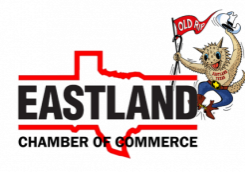History
Dive into the History of the Eastland
The Eastland Chamber of Commerce, which was chartered with the State of Texas on May 23, 1921, has been a long-standing influence in the community. It was established as a member organization, governed by a board of directors who were elected by a voting membership. The earliest known by-laws on file for the organization are dated October 16, 1919. Subsequent editions of these by-laws also exist in the files at the Chamber office and are an important part of early Eastland history.
Written minutes from as far back as 1926, reveal a unique account of early day business in Eastland and show that development of the business community was the focus from early on in the history of the Chamber of Commerce. Familiar old Eastland names appear time and again in these minutes, re-enforcing the strength and influence our early day businesses and citizens had on our community.
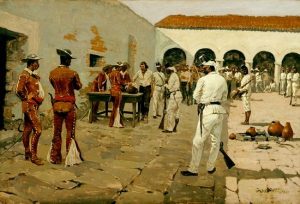 EASTLAND, WILLIAM MOSBY (1806-1843). William Mosby Eastland was born in Woodford County, Kentucky, on March 21, 1806, the son of Thomas B. and Nancy (Mosby) Eastland. He later moved to Texas in 1834 with his wife, children, two brothers, and a cousin. They settled near the site of present La Grange in Fayette County.
EASTLAND, WILLIAM MOSBY (1806-1843). William Mosby Eastland was born in Woodford County, Kentucky, on March 21, 1806, the son of Thomas B. and Nancy (Mosby) Eastland. He later moved to Texas in 1834 with his wife, children, two brothers, and a cousin. They settled near the site of present La Grange in Fayette County.
From July 25 to September 15, 1835, Eastland served as first lieutenant of a volunteer company under Col. John H. Moore against the Waco and Tawakoni Indians. Eastland went on to fight several major battles that helped in settling the frontier of Texas.
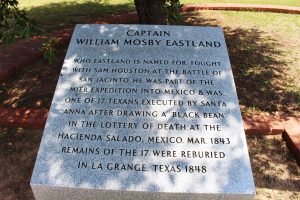 Eastland not only fought in frontier battles but also served in and led companies in the Texas Rangers as they fought for Texas’s independence from Mexico. In response to the raid of Adrián Woll in 1842, Eastland raised a company that he led to San Antonio; but he arrived too late to take part in the battle of Salado Creek. Eastland’s men joined forces with Col. James R. Cook’s First Regiment, Second Brigade, of Gen. Alexander Somervell’s Army of the South West for the subsequent Somervell expedition.
Eastland not only fought in frontier battles but also served in and led companies in the Texas Rangers as they fought for Texas’s independence from Mexico. In response to the raid of Adrián Woll in 1842, Eastland raised a company that he led to San Antonio; but he arrived too late to take part in the battle of Salado Creek. Eastland’s men joined forces with Col. James R. Cook’s First Regiment, Second Brigade, of Gen. Alexander Somervell’s Army of the South West for the subsequent Somervell expedition.
Eager for revenge for the killing of his cousin and nephew by Woll’s men, Eastland chose to remain on the Rio Grande with William S. Fisher’s command when Somervell ordered his expedition to return to San Antonio. Eastland was elected captain of Company B for the Mier expedition.
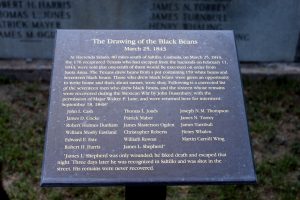 Eastland and his men were taken captive after the battle of Mier on December 26, 1842 and marched to the interior of Mexico. There he participated in the Texans’ abortive escape attempt and was the first of the Texans to draw a fatal black bean, the only officer of the expedition to do so. In a brief private interview with Fenton M. Gibbon Eastland said, “For my country I have offered all my earthly aspiration and for it I now lay down my life. I never have feared death nor do I now. For my unjustifiable execution I wish no revenge but die in full confidence of the Christian faith.” After giving his money to his brother-in-law, Robert Smith and sending word to his wife that “I die in the faith in which I have lived,” Eastland was shot to death, on March 25, 1843.
Eastland and his men were taken captive after the battle of Mier on December 26, 1842 and marched to the interior of Mexico. There he participated in the Texans’ abortive escape attempt and was the first of the Texans to draw a fatal black bean, the only officer of the expedition to do so. In a brief private interview with Fenton M. Gibbon Eastland said, “For my country I have offered all my earthly aspiration and for it I now lay down my life. I never have feared death nor do I now. For my unjustifiable execution I wish no revenge but die in full confidence of the Christian faith.” After giving his money to his brother-in-law, Robert Smith and sending word to his wife that “I die in the faith in which I have lived,” Eastland was shot to death, on March 25, 1843.
EASTLAND, TEXAS. Eastland, the county seat of Eastland County, is at the intersection of State highways 6 and 112, northwest of Interstate Highway 20 on the Missouri Pacific Railroad in the central part of the county.
In 1875 Jacamiah S. Daugherty and Charles U. Connellee purchased land on the C. S. Betts survey and platted a townsite. County voters opted to move the county seat from Merriman to the newly planted site, as it was closer to the center of the county, and the new community was named Eastland.
Connellee, Daugherty, J. B. Ammerman, and others built a stone courthouse, and the county commissioners court held its first session in the town in September of 1875. By January of 1876 the population was estimated at 250. The first public school was taught in the community in 1877, and Methodist, Baptist, and Christian churches were soon organized.
The city's growth was assured when, in 1880, the Texas and Pacific Railway was given a number of town lots to build through the community. Eastland Independent School District was established in 1882, and a second courthouse of red stone was constructed in 1883. By 1884 Eastland had three churches, a school, a flouring mill, two cotton gins, and an estimated 500 inhabitants. Among the early newspapers in the town were the Anchor and the Chronicle. Eastland was incorporated for the first time on June 6, 1891, with W Q. Connellee as the first mayor and for the second time on April 6, 1897, with June Kimble as mayor. The second courthouse was destroyed by fire in 1896, and a third courthouse was built the following year.
A horned lizard, later to become famous as "Old Rip," was supposedly placed in the cornerstone. When the third and final courthouse was erected in 1928, the cornerstone was opened, and the toad was found to have miraculously survived. Though many doubted the toad's authenticity, he (and eventually his remains) got quite a bit of state and even national publicity and became an important part of town and county lore.
Eastland grew slowly in the first decades of the twentieth century, reaching 596 inhabitants in 1900 and 855 in 1910. By 1914 the community had two banks, telephone service, and a public Library. The local economy was heavily dependent on cotton. Eastland County experienced a dramatic oil boom from 1917 to 1922, and the city of Eastland grew rapidly, though not as rapidly as other communities in the county, notably Ranger and Desdemona. Eastland population increased fourfold between 1910 and 1920, reaching 3,368 in 1920, though some estimates claim that there were as many as 10,000 people in the town during the height of the boom in 1919.
The town's prosperity in the 1920s helped fund city improvements like the new courthouse, a new high school, and the paving of city streets. The community reached its peak census population in 1930 with 4,648 inhabitants. Thereafter the city began a slow decline, falling to 3,849 inhabitants in 1940, 3,606 in 1950, and 3,178 in 1970. The community experienced some small-scale growth in the 1970s, as the number of businesses increased from 78 in 1972 to 154 in 1982, and the population increased to 3,747 in 1980. In 1990 Eastland had a population of 3,690 and in 2010, the population was 3,960. The local economy depended on county government, agribusiness, printing, and several manufacturing plants.
-Written by Ruby Pearl Ghormley
 Charles Ulrich Connellee, surveyor and state legislator, son of Sadosa T. and Lucy A. (Woods) Connellee, was born on August 21, 1851, in Scott County, Kentucky. After studying in the agricultural and mechanical department of the University of Lexington, he taught school in Scott County. In 1874 he was elected county surveyor, but in October of the same year he moved to Texas, where he established a real estate business in Dallas.
Charles Ulrich Connellee, surveyor and state legislator, son of Sadosa T. and Lucy A. (Woods) Connellee, was born on August 21, 1851, in Scott County, Kentucky. After studying in the agricultural and mechanical department of the University of Lexington, he taught school in Scott County. In 1874 he was elected county surveyor, but in October of the same year he moved to Texas, where he established a real estate business in Dallas.
In January 1875 he bought and staked out a public square on 320 acres centrally located in Eastland County. The tract had originally been surveyed by C. S. Betts. In May, Connellee, Jack S. Daugherty, and J. B. Ammerman, surveyed the town of Eastland and were influential in getting the new community made county seat.
During the early 1880s Connellee was a leader in efforts to eradicate Texas fever and improve cattle breeds for the area ranches. In 1887 he was elected as representative from the Forty-second District in the Twenty-first and Twenty-second legislatures. In 1911 he was a member of the board that located and established the state tuberculosis colony. He served as a regent of the College of Industrial Arts (now Texas Woman’s University) from 1925 until his death.
Connellee married Mattie E. Payne on April 22, 1875. They had four children. After her death he married Lulu Ostrom, on September 1, 1888. On June 14, 1894, he married Tully Hardeman. On March 15, 1924, he married Mrs. Bula B. Whittington. Connellee died in Fort Worth on December 2, 1930 and was buried in Eastland.
BIBLIOGRAPHY: Edwin T. Cox, History of Eastland County, Texas (San Antonio: Naylor, 1950). Lewis E. Daniell, Personnel of the Texas State Government, with Sketches of Representative Men of Texas (Austin: City Printing, 1887; 3d ed., San Antonio: Maverick, 1892). Fort Worth Star-Telegram, December 3, 1930. Ruby Pearl Ghormley, Eastland County, Texas: A Historical and Biographical Survey (Austin: Rupegy, 1969). Carolyne Lavinia Langston, History of Eastland County
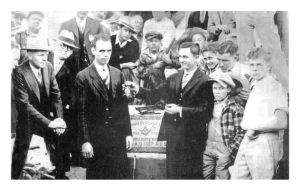 In 1897, a horned toad was placed in the cornerstone of the courthouse in Eastland, Texas, as it was being sealed. People remember the event, but no one thought much of it until 1928, when the courthouse was demolished to make way for a new, Jazz Art model. Three thousand people were on hand to watch the opening of the old cornerstone. The horned toad was found inside, flat and covered with dust, ALIVE, thirty-one years later.
In 1897, a horned toad was placed in the cornerstone of the courthouse in Eastland, Texas, as it was being sealed. People remember the event, but no one thought much of it until 1928, when the courthouse was demolished to make way for a new, Jazz Art model. Three thousand people were on hand to watch the opening of the old cornerstone. The horned toad was found inside, flat and covered with dust, ALIVE, thirty-one years later.
The toad was christened “Old Rip” and soon became a national sensation. He toured the U.S. and even met President Calvin Coolidge. He was so popular that local gas stations gave away complimentary Old Rip replicas to customers.
 Eleven months after his resurrection, Old Rip died of pneumonia. His body was embalmed and placed in a tiny, open, velvet lined casket in the lobby of the new courthouse. Today, the casket can be viewed from the outside by climbing the steps on the Main Street side and looking through the window at the top. Since that time, Old Rip’s life and demise has been commemorated on the last Monday in February at the Eastland County Courthouse.
Eleven months after his resurrection, Old Rip died of pneumonia. His body was embalmed and placed in a tiny, open, velvet lined casket in the lobby of the new courthouse. Today, the casket can be viewed from the outside by climbing the steps on the Main Street side and looking through the window at the top. Since that time, Old Rip’s life and demise has been commemorated on the last Monday in February at the Eastland County Courthouse.
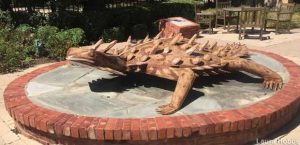 During the years, Old Rip has been featured in several television productions and documentaries including Ripley’s “Believe It or Not”. Recently, the Eastland Chamber of Commerce was contacted by an Austrian film maker who was making a nature documentary for the European version of Discovery Channel about animals in the Old West. Old Rip was included in the documentary for which the film maker won a European award equivalent to an Oscar.
During the years, Old Rip has been featured in several television productions and documentaries including Ripley’s “Believe It or Not”. Recently, the Eastland Chamber of Commerce was contacted by an Austrian film maker who was making a nature documentary for the European version of Discovery Channel about animals in the Old West. Old Rip was included in the documentary for which the film maker won a European award equivalent to an Oscar.
Horned lizards (or toads) are in danger of becoming extinct, and collecting Old Rip memorabilia is a popular pastime. For those who collect, our Old Rip merchandise is available at the Chamber of Commerce and in several shops around town.
- A Nehi soft drink bottling plant was once located on Main Street.
- A Coca-Cola bottling plant once occupied the lot that is the present site of First Financial Bank.
- Until the Great Depression, five banks were located around the square in Eastland.
- During the years of 1930-1934, Eastland had no bank at all.
- Eastland National Bank opened on November 4, 1934, and is still in business today as First Financial Bank.
- The Village Hotel, located in downtown Eastland, was built in 1928 by Mr. Jesse Jones. It was originally named the Connellee Hotel for C.U. Connellee.
- Peanuts are the chief money crop in Eastland County.
- Victor Cornelius, an Eastland businessman, installed the first coin-operated music machine in Central Texas in 1930.
- The first courthouse in Eastland was located on the second floor of a building that is now a beauty supply business. A grocery store was on the first floor, and the courthouse shared the second floor with the Masonic Hall.
- The current Eastland County courthouse was built in 1928. Inside was a law library with 5000 volumes. The building was illuminated at night by fourteen floodlights.
- The first funeral home in Eastland was established in 1923 by the Barrow family of Abilene. The Ben Hamner family operated it until it was sold to the Arringtons in 1964.
- The courthouse was the first building in Eastland to have an elevator.
- In the 1920's the street that is now Commerce Street was our main highway. It was called the Bankhead Highway.
- There are seventeen restaurants in Eastland at this time.
- The major employers in Eastland are
EBAA Iron, Inc.
Wal-Mart
Eastland Independent School District
Eastland Memorial Hospital
Cisco College
Ranger College
Eastland County
Eastlander Designs
City of Eastland - There are three medical clinics, one hospital, and two nursing homes in Eastland.
- The Ford Foundation donated $10,000 toward the construction of Eastland Memorial Hospital in 1956.
- The Bell Telephone Company building was purchased as a safe place for the hospital records in 1968 because the builders had not yet built a place in the hospital for the records.
- In February of 1950 the Otis Colemans opened the Dairy King in Eastland, serving the only soft-serve ice cream between Abilene and Fort Worth.
- The first newspaper in Eastland County was the Eastland Review, organized in 1876 by J. H. Davenport.
History and Geography
- Eastland County was created in 1858 and organized in 1873.
- Eastland was named after Capt. William Eastland, who never visited the town.
- Eastland County has an area of 925 square miles.
- The average altitude of Eastland County is 1400 feet.
- Eastland is located in the area known as the Western Cross Timbers.
- The county is watered by some eighteen creeks and rivers.
- Lake Leon, Eastland's water source, was built in the 1950's. Local lore says that while it was being built it rained for days and filled up the lake, leaving some of the equipment under water. It is supposedly still there today.
- In October of 1981, the north part of town flooded after thirteen inches of rain fell in one night.
- Ringling Lake got its name from the Ringling Railroad which was 27 miles long and ran from Carbon to near Breckenridge. John Ringling, of Ringling Bros., helped fund the railroad.
- Eastland still has some brick streets. The bricks were made in Thurber, Texas, about thirty miles away.
- The Eastland City Park was built as Eastland Tourist Park during the 1920's.
- In May 1980, a new county jail opened. It complied with all state mandates for space and other regulations.
- The Majestic Theater was once the Connellee Theater, and the Village Hotel was the Connellee Hotel, both named for one of the founders of the city.
- The oil boom in Ranger brought a lot of legal activity and lawyers to Eastland, which is the county seat. With so much business and activity, a larger courthouse was built in 1928 and is still in use today. It houses one of fourteen Courts of Appeals in Texas.
- In May of 1985, a tank truck and an eastbound Missouri Pacific freight train collided at an Eastland crossing, causing the derailment of twenty-five of the ninety-nine train cars. Because of the intense heat, shock waves, and dangerous substances, an surrounding area of one mile had to be evacuated. There were a number of injuries and many buildings were damaged, including the courthouse.
- Old Rip the horned toad made Eastland famous by visiting President Coolidge and by being put in"Ripley's Believe It or Not."
- Eastland High School sits atop a hill overlooking Eastland and much of the surrounding territory.
- Before the late 1920's Eastland High School was located where the hospital now stands.
- In 1946 Eastland got a new football stadium with lights.
- A fighting ship, an addition to Uncle Sam's mighty naval fleet, was named the USS Eastland in honor of Eastland County in 1944.
Architecture and Landmarks by
- Most of the buildings on Eastland's square were built in the 1920's.
- Eastland's first courthouse was built in 1883 and burned down in 1896.
- An itinerant worker named James Fox fell off the roof of the courthouse and died. He is buried in the Eastland Cemetery. One of his fellow laborers made a tombstone for him.
- The second courthouse was completed in 1897 and was torn down in 1927.
- The present courthouse was completed in 1928.
- Judge Connellee, Eastland's founder, owned a horse race track located in a field between Seaman and Daugherty Streets.
- Siebert Elementary was named for Mr. Wendell Siebert, Eastland's superintendent of schools for many years.
- Two elementary schools, South Ward and West Ward, preceded Siebert Elementary.
- There is a monument at the football field that commemorates the Eastland Mavericks' State Championship football team of 1982.
- The current football stadium, built in 1946, was remodeled in the I 980's with new bleachers, lights, concession stands, restrooms, and ticket booths.
- In 1897 a horned toad was placed in the cornerstone of the new courthouse. Thirty years later the courthouse .was torn down to make room for a new, larger one. A worker lifted out the horned toad and he was alive! Now we call him "Old Rip." (Old Rip died of pneumonia about a year after his "resurrection.")
- Eastland was founded by C. U. Connellee, J.B. Ammerman, and J. S. Daugherty.
- Judge Connellee built a mansion for himself. It still stands at 515 S. Lamar and is now the home of Judge and Mrs. Austin McCloud.
- In 1956, postmistress Marene Johnson designed a floral replica of the American flag and planted the flowers by the post office. Mrs. Johnson and her crew used 1,250 flowers, mostly petunias and vinca, to make the "flag," which measured 18' x 40'.
- Mrs. Johnson also designed a mural made entirely of postage stamps. It is located in the lobby of the post office and is worth about a million dollars.
- There is a World War I monument on the lawn of the courthouse.
- Eastland Memorial Hospital was built in 1956 by members of the community.
- Commerce Street was once the Bankhead Highway, which was named after a United States Senator.
- On November 19, 1929, an angry mob hung Marshall Ratliff for robbing the Cisco National Bank while wearing a Santa suit. The hanging took place behind the Majestic Theater.
- It took two ropes to hang Mr. Ratliff. The first one broke.
Education and Religion
- Yellow Mound School, established in 1890, had thirty students with all grades in the same classroom, and a three-month school term. The school got its name from a yellow mound of dirt.
- The current high school was built in 1927.
- The old Eastland High School was located where Eastland Memorial Hospital is today.
- From 1930-1935 there was a university located in Eastland called Warner Memorial University.
- The first teacher in Eastland was Mr. George W. Crutcher who came to Texas in 1875.
- The Eastland Independent School District was formed in 1916.
- In 1904 Eastland High School had three female teachers and a superintendent.
- C. U. Connellee was president of the Board of Trustees in 1904.
- The first schoolhouse in the vicinity of Eastland was a log cabin.
- An Eastland teacher's salary in 1911-12 was $40-50 a month.
- The Village Hotel was the site of the high school prom in the l 950's.
- The Marshall Complex, home of EHS basketball, was completed in 1995 and named after longtime Eastland educators Charles and Lois Marshall.
- The First United Methodist Church of Eastland was organized in 1875.
- In I 876 Reverend Lingo met with a group of Baptist men and women on the upper floor of a sawmill to organize the First Baptist Church in Eastland.
- First Baptist Church built a church building in 1927 for $30,000.
- The first service was held in that building on June 1, 1930.
- The oldest church building currently in use in Eastland is the First Christian Church, built in 1907.
- An arsonist set fire to the Holy Trinity Episcopal Church in 1996.
- The First Church of God was located in the building located on the corner of S. Lamar and Plummer.
- The First Christian Church originally met upstairs in the downtown building which now houses The Austin McCloud Appellate Court Museum.
Personalities
- In the early l 920's female pilot Agnes Doyle crashed into the Eastland Airport, fell 500 feet, and lived to tell about it.
- A Ringling Brother (as in the circus guys) solved the problem of transporting water to Eastland from Breckenridge by building a railroad.
- The Eastland High School Band appeared on WBAP-TV in Fort Worth in 1952.
- Aunt Jane Bowles was the first black woman in Eastland.
- Eastland's first teacher was George W. Crutcher.
- Judge Connellee named these streets after his loved ones:
Mulberry-his sweetheart Susan Mary Mulberry
Rosewood-his daughter, Rose
Sadosa-his father
Patterson and White-two of his law professors
Dixie-his sister - Mr. Daugherty named these streets after his loved ones:
Seaman-his mother's maiden name
Halbryan-his brother-in-law - Mr. Ammerman named Bassett Street after his brother.
- Phil Hewitt was Eastland's band director twice, in the '60's and in the '80's.
- Eastland is named after Captain William Mosby Eastland who fought for Texas's freedom from Mexico. When he was captured by the enemy he drew a black bean and was executed.
- There is a local legend about a woman known as "Screaming Sheila." It seems that Sheila and her two brothers were walking across a bridge. The bridge collapsed and they all drowned in Eastland Lake. The brothers' bodies were found, but Sheila's body was never recovered. Some say that at night you can still hear her screams.
- Another version of the Screaming Sheila legend says that Sheila and her baby were walking across the bridge. Her baby crawled off the bridge and Sheila went off after him. The story goes that if you go to Ringling Lake at night, flash your lights, and scream Sheila's name, Sheila will come after you.
- William Pike Tindall was Eastland's only San Jacinto hero. He was a direct descendant of William Tyndale, the first man to translate the New Testament from Greek to English.
- C. U. Connellee' s tombstone states that he was the "Founder of Eastland."
- Mr. C. C. High put up the first blacksmith shop in Eastland.
- Artie Lyles was the oldest living Maverick football player.
- Dr. Jackson Evans was the first doctor in Eastland County.
- A Mexican name Frank Sanchez was said to have been the first settler in the county.
- The last mob lynching in Texas was in Eastland, the hanging of Marshall Ratliff, also known as the "Santa Claus bank robber.
- Wanda Hull opened Eastland's first convenience store in the 1960's.
